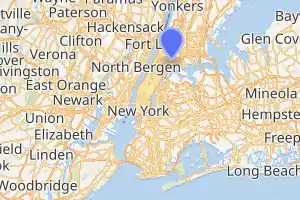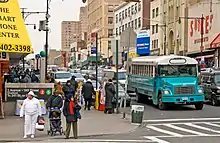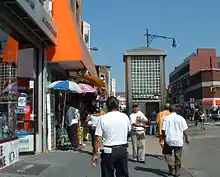The Hub, Bronx
The Hub is the retail, theater, and restaurant heart of the South Bronx, New York. It is located where four roads converge: East 149th Street, and Willis, Melrose and Third Avenues.[1] It is primarily located inside the neighborhood of Melrose but also lines the northern border of Mott Haven.[2]
The Hub | |
|---|---|
 | |
| Nickname(s): "the Broadway of the Bronx" | |

Location in New York City | |
| Coordinates: 40.816°N 73.917°W | |
| Locale | South Bronx, New York City, New York |
| Subway services | |
| Bus routes | Bx2, Bx4, Bx4A, Bx15, Bx19, Bx21, Bx32, Bx41, Bx41 SBS |
The Hub, short for "the Hub of the Bronx,"[3][4] has also been called "the Broadway of the Bronx".[5] It is the site of both maximum traffic and architectural density. In configuration, it resembles a miniature Times Square, a spatial "bow-tie" created by the geometry of the street intersections.[6] It is a primary shopping district for Bronx residents, and many new hip hop trends can be found in the Hub long before they spread to the rest of New York City and the world.
The area is part of Bronx Community Board 1.[7]
History

The Hub is the oldest major shopping locale in the Bronx.[8] Between 1900 and 1930, the number of Bronx residents increased from 201,000 to 1,265,000. Inhabitants throughout the borough shopped in department stores and boutiques at 149th Street and 3rd Avenue, an area that came to be known in this time as "the Hub". In the 1930s the Hub had movie palaces and vaudeville theaters.[9] These included the Bronx Opera House, which today operates as a boutique hotel, and the former Jackson Theatre.[10][11]
A few decades after it became a national symbol of urban decay, the South Bronx is now home to several new construction projects that are rebuilding neighborhoods that have seen little new construction in half a century.[12] On March 14, 2006, Mayor Michael Bloomberg and other elected officials took part in the symbolic groundbreaking ceremony for the new "Hub Retail and Office Center".[13] After a year and a half of construction, the Hub Retail and Office Center opened in the middle of 2007. Current tenants include Staples, Rite Aid, and Forman Mills, a clothing store opening its first New York store in the Bronx. Upcoming tenants include Nine West and Sleepy's. As a result, the Hub's district is extended to East 156th Street in Melrose.
Shopping traffic in the Hub is generated via foot, car, and public transportation. The sidewalks in the Hub are often packed with people. Merchants hawk their wares by calling out to the crowd or passing out small handbills. Music stores offer a wide selection of hip-hop, reggae, gospel, and Latin music. Craft stores have knitting and sewing supplies. Local clothing stores such as Revolution Boutique compete with major chains like Jimmy Jazz and Foot Locker.
Triangle Plaza Hub
A new complex with mixed-use office and retail space that is slated to open in the fall of 2015. Notable tenants already include Fine Fare Supermarket, Metropolitan College of New York, Vistasite Eye Care and Boston Market.[14]
Transportation

The following MTA Regional Bus Operations bus routes serve the Hub:[15]
- Bx2: to Riverdale (AM hours & Sundays Only), Kingsbridge Heights or Third Avenue–138th Street station (via Grand Concourse) all other times
- Bx4 / Bx4A: to Westchester Square (4 via Westchester Avenue, 4A via Westchester and Metropolitan Avenues)
- Bx15: to Fordham Plaza or Manhattanville (via Third Avenue)
- Bx19: to New York Botanical Garden or Riverbank State Park (via 149th Street–Southern Boulevard)
- Bx21: Westchester Square or Third Avenue–138th Street station (via Boston Road)
- Bx32: to VA Hospital or Third Avenue–138th Street station (via Morris-Jerome Avenues)
- Bx41 and Bx41 SBS: to Williamsbridge, Gun Hill Road (via Webster Avenue)
The following New York City Subway stations serve the Hub:[16]
- Third Avenue–149th Street subway station on the IRT White Plains Road Line (2 and 5 trains)
The Hub does not have a nearby Metro-North Railroad station, but the Melrose station is a few blocks north at 162nd Street and Park Avenue. In 1902 a large Grand Union Station was proposed near the now-closed 138th Street station,[17] half a mile from the Hub, which would have been served by many of the railroads entering Manhattan at the time. However, this was never built.
The 149th Street station on the Third Avenue elevated operated from 1887 to 1973.
References
- The Hub from Forgotten-NY.com
- "People, Shops and Roads Converge Here". Retrieved 11 September 2015.
- "Bronx Has New Crosstown Trolley Line Entering Manhattan Through 149th Street" (PDF). The New York Times. October 22, 1911. Retrieved 7 October 2015.
- "THE REAL ESTATE FIELD; Bronx Plot Sells for $200 a Front Foot -- John D. Rockefeller, Jr., Takes Title to the Francis S. Kinney House -- $148,000 Paid for Theatre and Office Building Site in Jamaica, L.I." (PDF). The New York Times. March 2, 1912. Retrieved 7 October 2015.
- "Bronx Hub revival gathers steam". Retrieved 11 September 2015.
- Bronx Hub Archived 2009-08-01 at the Wayback Machine
- "Bronx Community District 1" (PDF). Archived from the original (PDF) on 4 March 2016. Retrieved 25 September 2015.
- Community Board District 1, The South Bronx. Accessed September 23, 2007.
- A Brief Look at The Bronx Archived 2007-08-07 at the Wayback Machine, Bronx Historical Society. Accessed September 23, 2007.
- "Jackson Theatre". cinematreasures.org. Retrieved 24 November 2015.
- "The Bronx is booming with boutique and luxury hotels". NY Daily News. Retrieved 25 September 2015.
- Williams, Timothy (March 19, 2006). "Now Booming, Not Burning, the Bronx Fears a Downside". The New York Times. Retrieved September 23, 2007.
- "Mayor Bloomberg Outlines Latest Successes Of The Administration's Five Borough Economic Development Strategy During Weekly Radio Address". Retrieved 11 September 2015.
- "South Bronx commercial hub will now include health and dialysis centers". Retrieved 11 September 2015.
- "Bronx Bus Map" (PDF). Metropolitan Transportation Authority. October 2018. Retrieved December 1, 2020.
- "Subway Map" (PDF). Metropolitan Transportation Authority. October 21, 2019. Retrieved January 18, 2018.
- "New Grand Union Station Proposed for the Bronx". The New York Times. November 2, 1902. p. 25. Retrieved August 27, 2010.
External links
| Wikimedia Commons has media related to The Hub, Bronx. |

